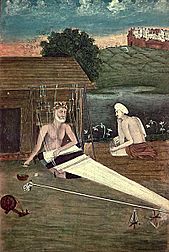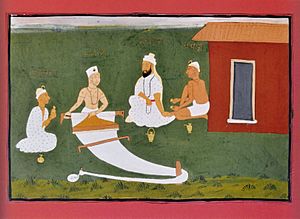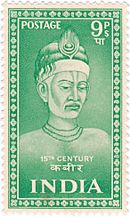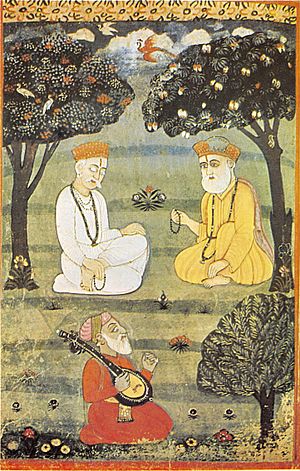Kabir facts for kids
Quick facts for kids
Kabir
|
|
|---|---|

Painting of Kabir weaving, c. 1825
|
|
| Born | 1398 |
| Died | 1518 (Aged - Approx. 120 years) Maghar, Lodhi dynasty
|
|
Main interests
|
|
|
Influences
|
|
|
Influenced
|
|
Kabir (1398–1518) was a 15th-century Indian mystic poet and saint. His writings influenced Hinduism's Bhakti movement, and his verses are found in Sikhism's scripture Guru Granth Sahib, the Satguru Granth Sahib of Saint Garib Das, and Kabir Sagar.
Born in the city of Varanasi in what is now Uttar Pradesh, he is known for being critical of both organized religion and religions. He questioned what he regarded to be the meaningless and unethical practices of all religions, primarily what he considered to be the wrong practices in the Hindu and Muslim religions. During his lifetime, he was threatened by both Hindus and Muslims for his views. When he died, several Hindus and the Muslims he had inspired claimed him as theirs.
Kabir suggested that "Truth" is with the person who is on the path of righteousness, considered everything, living and non living, as divine, and who is passively detached from the affairs of the world. To know the Truth, suggested Kabir, drop the "I", or the ego. Kabir's legacy survives and continues through the Kabir panth ("Path of Kabir"), a religious community that recognises him as its founder and is one of the Sant Mat sects. Its members are known as Kabir panthis.
Contents
Early life and background
The years of Kabir's birth and death are unclear. Some historians favour 1398–1448 as the period Kabir lived, while others favour 1440–1518. Generally, Kabir is believed to have been born in 1398 (Samvat 1455), on the full moon day of Jyeshtha month (according to the historical Hindu calendar Vikram Samvat) at the time of Brahmamuharta. There is a considerable scholarly debate on the circumstances surrounding Kabir's birth. Many Followers of Kabir believe that he came from Satloka by assuming the body of light, and incarnated on a lotus flower and claim that the rishi Ashtanand was the direct witness of this incident, who himself appeared on a lotus flower in the Lahartara Pond.
A few accounts mention that Kabir in the form of a child was found at Lahartara Lake by a Muslim weaver called Niru and his wife Nima who raised him as his parents.
Kabir is widely believed to have become one of the many disciples of the Bhakti poet-saint Swami Ramananda in Varanasi, known for devotional Vaishnavism with a strong bent to monist Advaita philosophy teaching that God was inside every person, everything. Early texts about his life place him with Vaishnava tradition of Hinduism as well as the Sufi tradition of Islam. According to Irfan Habib, the two manuscript versions of the Persian text Dabistan-i-Mazahib are the earliest known texts with biographical information about Kabir. The Dabistan-i-Mazahib states Kabir is a "Bairagi" (Vaishnava yogi) and states he is a disciple of Ramanand (the text refers to him repeatedly as "Gang").
Kabir's family is believed to have lived in the locality of Kabir Chaura in Varanasi (Banaras). Kabīr maṭha (कबीरमठ), a maṭha located in the back alleys of Kabir Chaura, celebrates his life and times. Accompanying the property is a house named Nīrūṭīlā (नीरू टीला) which houses Niru and Nima graves.
Poetry
Kabir's poems were in vernacular Hindi, borrowing from various dialects including Braj, Bhojpuri and Awadhi. They cover various aspects of life and call for a loving devotion for God. Kabir composed his verses with simple Hindi words. Most of his work was concerned with devotion, mysticism and discipline.
Kabir and his followers named his verbally composed poems of wisdom as "bāņīs" (utterances). These include songs and couplets, called variously dohe, śalokā (Sanskrit: ślokā), or sākhī (Sanskrit: sākṣī). The latter term means "witness", implying the poems to be evidence of the Truth.
Literary works with compositions attributed to Kabir include Kabir Bijak, Kabir Parachai, Sakhi Granth, Adi Granth (Sikh), and Kabir Granthawali (Rajasthan). However, except for Adi Granth, significantly different versions of these texts exist and it is unclear which one is more original; for example, Kabir Bijak exists in two major recensions. The most in depth scholarly analysis of various versions and translations are credited to Charlotte Vaudeville, the 20th century French scholar on Kabir.
There are 82 works attributed to Kabir as mentioned in Kabir and the Kabir panth by Westcott. Shyamsundar das himself brought to light two remarkable manuscripts which he published in 1928. One of these manuscripts carried the date 1504 and the other 1824. It was certainly an important finding.
Kabir's poems were verbally composed in the 15th century and transmitted viva voce through the 17th century. Kabir Bijak was compiled and written down for the first time in the 17th century. Scholars state that this form of transmission, over geography and across generations bred change, interpolation and corruption of the poems. Furthermore, whole songs were creatively fabricated and new couplets inserted by unknown authors and attributed to Kabir, not because of dishonesty but out of respect for him and the creative exuberance of anonymous oral tradition found in Indian literary works. Scholars have sought to establish poetry that truly came from Kabir and its historicity value.
Authenticity
Numerous poems are attributed to Kabir, but scholars now doubt the authenticity of many songs credited to him.
Rabindranath Tagore's English translation and compilation One Hundred Poems of Kabir was first published in 1915, and has been a classic reprinted and widely circulated particularly in the West. Scholars believe only six of its hundred poems are authentic, and they have questioned whether Tagore introduced then prevalent theological perspectives onto Kabir, as he translated poems in early 20th century that he presumed to be of Kabir's. The unauthentic poems nevertheless belong to the Bhakti movement in medieval India, and may have been composed by admirers of Kabir who lived later.
Philosophy
According to Linda Hess, "Some modern commentators have tried to present Kabir as a synthesizer of Hinduism and Islam; but the picture is a false one. While drawing on various traditions as he saw fit, Kabir emphatically declared his independence from both the major religions of his countrymen, vigorously attacked what he considered the follies of these religions, and tried to kindle the fire of a similar autonomy and courage in those who claimed to be his disciples. He adopted their terminology and concepts, but vigorously criticized them both. He questioned the need for any holy book, as stated in Kabir Granthavali as follows:
Many scholars interpret Kabir's philosophy to be questioning the need for religion, rather than attempting to propose either Hindu–Muslim unity or an independent synthesis of a new religious tradition. Kabir rejected the hypocrisy and misguided rituals evident in various religious practices of his day, including those in Islam and Hinduism.
In Bijak, Kabir mocks the practice of praying to avatars such as Buddha of Buddhism, by asserting "don't call the master Buddha, he didn't put down devils". Kabir urged people to look within and consider all human beings as manifestation of God's living forms:
Charlotte Vaudeville states that the philosophy of Kabir and other sants of the Bhakti movement is the seeking of the Absolute. The notion of this Absolute is nirguna which, writes Vaudeville, is same as "the Upanishadic concept of the Brahman-Atman and the monistic Advaita interpretation of the Vedantic tradition, which denies any distinction between the soul [within a human being] and God, and urges man to recognize within himself his true divine nature". Vaudeville notes that this philosophy of Kabir and other Bhakti sants is self-contradictory, because if God is within, then that would be a call to abolish all external bhakti. This inconsistency in Kabir's teaching may have been differentiating "union with God" from the concept of "merging into God, or Oneness in all beings". Alternatively, states Vaudeville, the saguna prema-bhakti (tender devotion) may have been prepositioned as the journey towards self-realization of the nirguna Brahman, a universality beyond monotheism.
David N. Lorenzen and Adrián Muñoz trace these ideas of God in Kabir's philosophy as nirguna Brahman to those in Adi Shankara's theories on Advaita Vedanta school of Hinduism, albeit with some differences.
Influence of Islam
Kabir criticized practices such as killing and eating a cow by Muslims, in a manner Hindus criticized those practices.
Persecution and social impact
Kabir's couplets suggest he was persecuted for his views, while he was alive. He stated, for example,
Kabir response to persecution and slander was to welcome it. He called the slanderer a friend, expressed gratefulness for the slander, for it brought him closer to his god. Winand Callewaert translates a poem attributed to Kabir in the warrior-ascetic Dadupanthi tradition within Hinduism, as follows:
The legends about Kabir describe him as the underdog who nevertheless is victorious in trials by a Sultan, a Brahmin, a Qazi, a merchant, a god or a goddess. The ideological messages in the legends appealed to the poor and oppressed. According to David Lorenzen, legends about Kabir reflect a "protest against social discrimination and economic exploitation", they present the perspective of the poor and powerless, not the rich and powerful. However, many scholars doubt that these legends of persecution are authentic, point to the lack of any corroborating evidence, consider it unlikely that a Muslim Sultan would take orders from Hindu Brahmins or Kabir's own mother demanded that the Sultan punish Kabir, and question the historicity of the legends on Kabir.
Legacy
Kabir literature legacy was championed by two of his disciples, Bhāgodās and Dharmadās. Songs of Kabir were collected by Kshitimohan Sen from mendicants across India, these were then translated to English by Rabindranath Tagore.
New English translations of Songs of Kabir is done by Arvind Krishna Mehrotra. August Kleinzahler writes about this: "It is Mehrotra who has succeeded in capturing the ferocity and improvisational energy of Kabir’s poetry".
Kabir's legacy continues to be carried forward by the Kabir panth ("Path of Kabir"), a religious community that recognises him as its founder and is one of the Sant Mat sects. This community was founded centuries after Kabir died, in various parts of India, over the seventeenth and eighteenth centuries. Its members, known as Kabir panthis, are estimated to be around 9.6 million. They are spread over north and central India, as well as dispersed with the Indian diaspora across the world, up from 843,171 in the 1901 census.
There are two temples dedicated to Kabir located in Benares. One of them is maintained by Hindus, while the other by Muslims. Both the temples practise similar forms of worship where his songs are sung daily. Other rituals of aarti and distributing prasad are similar to other Hindu temples. The followers of Kabir are vegetarians.
Kabir, Guru Nanak and the Guru Granth Sahib
Kabir's verses were incorporated into Adi Granth, the scripture of Sikhism, with verses attributed to Kabir constituting the largest non-Sikh contribution.
Some scholars state Kabir's ideas were one of the many influences on Guru Nanak, who went on to found Sikhism in the fifteenth century. Other Sikh scholars disagree, stating there are differences between the views and practices of Kabir and Nanak.
Harpreet Singh, quoting Hew McLeod, states, "In its earliest stage Sikhism was clearly a movement within the Hindu tradition; Nanak was raised a Hindu and eventually belonged to the Sant tradition of northern India, a movement associated with the great poet and mystic Kabir." Surjit Singh Gandhi disagrees, and writes "Guru Nanak in his thought pattern as well as in action model was fundamentally different from Kabir and for that matter other radical Bhaktas or saints (saint has been erroneously used for such Bhaktas by Mcleod). Hence to consider Kabir as an influence on Guru Nanak is wrong, both historically and theologically".
McLeod places Nanak in the Sant tradition that included Kabir and states that their fundamental doctrines were reproduced by Nanak. JS Grewal contests this view and states that McLeod's approach is limiting in its scope because, "McLeod takes into account only concepts, ignores practices altogether, he concentrates on similarities and ignores all differences".
Criticism
Kabir has been criticised for his depiction of women. Nikky-Guninder Kaur Singh states, "Kabir's opinion of women is contemptuous and derogatory". Wendy Doniger concludes Kabir had a misogynist bias. Schomer states that for Kabir, woman is "kali nagini (a black cobra), kunda naraka ka (the pit of hell), juthani jagata ki (the refuse of the world)". According to Kabir, a woman prevents man's spiritual progress.
In contrast to Singh's interpretation of Kabir's gender views, Dass interprets Rag Asa section of Adi Granth as Kabir asking a young married woman to stop veiling her face, and not to adopt such social habits. Dass adds that Kabir's poetry can be interpreted in two ways, one literally where the woman refers to human female, another allegorically where woman is symbolism for his own soul and Rama is the Lord-husband.
See also
 In Spanish: Kabir para niños
In Spanish: Kabir para niños




